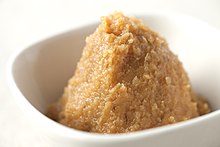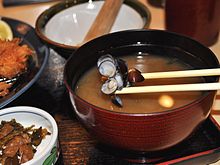Miso soup
 | |
| Type | Soup |
|---|---|
| Place of origin | Japan |
| Serving temperature | Hot |
| Main ingredients | Dashi stock, miso paste |
| Similar dishes | Doenjang-guk, doenjang-jjigae |
Miso soup (味噌汁 or お味噌汁, miso-shiru or omiso-shiru, お-/o- being honorific) is a traditional Japanese soup consisting of miso paste mixed with a dashi stock. It is commonly served as part of an ichijū-sansai (一汁三菜) meal, meaning "one soup, three dishes," a traditional Japanese meal structure that includes rice, soup, and side dishes. [1] Optional ingredients based on region and season may be added, such as wakame, tofu, negi, abura-age, mushrooms, etc. Along with suimono (clear soups), miso soup is considered to be one of the two basic soup types of Japanese cuisine.[2] It is a representative of soup dishes served with rice.
Miso soup is also called omiotsuke (御御御付) in some parts of Japan, especially around Tokyo.
Miso paste

The type of miso paste chosen for the soup defines a great deal of its character and flavor. Miso pastes (a traditional Japanese seasoning produced by fermenting soybeans with salt and the fungus Aspergillus oryzae, known in Japanese as kōjikin (麹菌), and sometimes rice, barley, or other ingredients) can be categorized into red (akamiso), white (shiromiso), or mixed (awase).[3] There are many variations within these themes, including regional variations, such as Shinshū miso or Sendai miso.
The amount of time taken also affects its flavor: a miso paste that has been fermented for a shorter period of time, such as a white miso, provides a lighter, sweeter flavor, while one which has been fermented for a longer period, such as a red miso, gives the miso soup a stronger, deeper one.[4]
More than 80% of Japan's annual production of miso is used in miso soup, and 75% of all Japanese people consume miso soup at least once a day.[5]
Stock

The most common dashi soup stocks for miso soup are made of niboshi (dried baby sardines), kombu (dried kelp), katsuobushi (thin shavings of dried and smoked bonito (similar to skipjack tuna)), or hoshi-shiitake (dried shiitake). The kombu can also be used in combination with katsuobushi or hoshi-shiitake. The kelp and/or shiitake dashi serve as a vegetarian soup stock.[6]
When the ingredients involve clams such as asari, shijimi, or hamaguri, they will impart flavorings that serve the role of dashi and thus it is not necessary to prepare any stock in advance.
Outside Japan, American or European style miso soup is sometimes made by dissolving miso in a Western vegetable stock. The stock might include ingredients such as negi, carrot, potato and daikon radish. In some versions of the dish, chicken stock, Western-style fish stock, and other non-dashi bases can even be used, but there is some debate over whether or not miso soups made using these non-traditional bases count as true miso soup.
Other ingredients

According to Japanese custom, ingredients are chosen to reflect the seasons and to provide contrasts of color, texture, and flavor. Thus negi and tofu, a strongly flavored ingredient mixed with a mildly flavored ingredient, are often combined. Ingredients that float, such as wakame seaweed, and ingredients that sink, such as potatoes, are also combined. Ingredients may include mushrooms (nameko or shiitake), potato, taro, seaweed, green laver, onion, nira, common bean, mitsuba, shrimp, fish, clams, and sliced daikon. Almost any Japanese ingredient may be added to some type of miso soup. However typical miso soup recipes contain a small number of additional ingredients beyond dashi stock and miso.
If pork is added to miso soup it is called tonjiru, meaning ‘pork soup’. Tonjiru is a soup served for dinner and lunch and not usually eaten for breakfast.
Hearty and robust cold-weather variations may include daikon, deep-fried tofu called abura-age, potatoes, onions and dark miso. Lighter variations are better suited for spring and summer and made with ingredients such as cabbage, seri myoga and/or eggplant.
Preparation and serving


Miso soup can be prepared in several ways, depending on the chef and the style of soup. Japanese recipes usually call for most vegetables to be cooked in the simmering dashi, particularly mushrooms, daikon, carrots, potatoes, tofu, and fish. The miso is suspended separately in some dashi stock removed from the simmering mix, to keep the miso paste from cooking, which alters the flavour, kills beneficial bacteria, and reduces the health benefits of biologically active miso paste. When the vegetables are cooked, the stock is removed from heat, the miso suspension is added and mixed into the soup, any uncooked ingredients are added, and the dish is served.
In Japan, miso soup and white rice make up the central dishes of the traditional Japanese breakfast. The soup has been a favorite of commoners and royalty alike for many centuries, but there are also many other dishes involving breakfast. They are all quite small, some include egg, fish, and nattō which is a fermented soybean. The soup is usually served in lacquer bowls with lids and drunk directly from the bowl, though the solid ingredients are eaten with chopsticks. The bowl sometimes has a lid to keep heat and aroma in as well as to improve the presentation.[7]
Instant miso soup

Instant miso soup is available in single-serving packets. It is usually sold in dehydrated powder and paste forms, though it is sometimes also sold freeze dried. It generally contains dried toppings such as wakame and tofu with soybeans that reconstitute rapidly on the addition of hot water.[8] These are popular in the Japanese workplace, where miso soup can be made with lunch as easily as green tea and using the same water. Instant miso soup is available in many grocery stores outside Japan. It has a shelf life of 3 to 12 months.
Wappani
Wappani (わっぱ煮), a miso-soup-based dish, is unique to Awashima island off the coast of Niigata, Japan. A cedar flask ("wappa") is filled with miso soup, fish and vegetables. It is then heated by dropping in hot rocks, which quickly brings it to a simmer. Hot rocks retain their heat for hours after being taken from the fire, so a hot meal can be prepared without the use of fire.[9]
Health benefits
In 2003, researchers at Japan's National Cancer Centre suggested that eating three or more bowls of miso soup every day could lower the risk of breast cancer in women.[10]
Studies in 2020 showed that habitual consumption of miso soup has the effect of lowering blood pressure and heart rate,[11] causing proliferation of good bacteria in the intestines and helping to prevent constipation.[12]
A 2003 epidemiology study in Japan discovered that persons who consume miso soup daily have a lower risk of stomach cancer and heart disease. In 2019 research concluded that fermented soy foods, such as miso, have antidiabetic, antioxidant (anti aging), anti-obesity, anti‐inflammatory, anticancer and antihypertensive (lowering blood pressure) properties.[13]
Gallery
-
With egg
-
With asari clams
-
With shrimp head
-
With rice
-
Red miso soup
See also
References
- ^ Tsuji, Shizuo (17 February 2012). Japanese Cooking: A Simple Art. Vertical. ISBN 978-1-56836-388-2.
- ^ Sakai, Sonoko (19 November 2019). Japanese Home Cooking: Simple Meals, Authentic Flavors. Roost Books. p. 118. ISBN 9780834842489.
- ^ "What Is Miso Paste, Anyway, And How Do I Use It? Help!". HuffPost. 2016-04-26. Archived from the original on 2018-12-14. Retrieved 2018-12-14.
- ^ Delany, Alex (27 March 2018). "5 Ways to Use Miso That Don't Involve Soup". Bon Appetit. Archived from the original on 2018-12-14. Retrieved 2018-12-14.
- ^ Shurtleff, William; Aoyagi, Akiko (2001). The Book of Tofu & Miso. Ten Speed Press. ISBN 1-58008-358-7.
- ^ "How To Make Miso Soup". Kitchn. Archived from the original on 2018-12-14. Retrieved 2018-12-14.
- ^ Matsune, Kaz (21 October 2016). "Why Is Miso Soup Sometimes Served With a Lid?". Slate.
- ^ "A Great Souvenir! Learn How To Make Instant Miso Soup". MATCHA - JAPAN TRAVEL WEB MAGAZINE. Archived from the original on 2018-12-14. Retrieved 2018-12-14.
- ^ "Wappani - 【郷土料理ものがたり】". kyoudo-ryouri.com. Archived from the original on 2018-12-14. Retrieved 2018-12-14.
- ^ "Miso soup 'cuts breast cancer risk'". 2003-06-18. Archived from the original on 2017-07-29. Retrieved 2018-12-14.
- ^ Ito 2020
- ^ Ichikawa 2020
- ^ Saeed, Farhan; Afzaal, Muhammad; Shah, Yasir Abbas; Khan, Mujahid Hassan; Hussain, Muzzamal; Ikram, Ali; Ateeq, Huda; Noman, Muhammad; Saewan, Shamaail A.; Khashroum, Ashraf O. (December 2022). "Miso: A traditional nutritious & health-endorsing fermented product". Food Science & Nutrition. 10 (12): 4103–4111. doi:10.1002/fsn3.3029. PMC 9731531. PMID 36514754.
Works cited
- Ito, Koji (2020-08-31). "Review of the health benefits of habitual consumption of miso soup: focus on the effects on sympathetic nerve activity, blood pressure, and heart rate". Environmental Health and Preventive Medicine. 25 (1): 45. Bibcode:2020EHPM...25...45I. doi:10.1186/s12199-020-00883-4. PMC 7461326. PMID 32867671.
- Ichikawa, Tomomi (2020-03-25). "若年女性における排便状況と食事からの発酵食品摂取の関係" [A Study of the Relationship between Constipation Assessment and the Intake of Fermented Foods in the Diet of Young Women]. Journal of the Faculty of Human Life Studies (in Japanese). 7: 17–21. Archived from the original on 2021-08-05. Retrieved 2020-10-03.
Further reading
- The Miso Book: The Art of Cooking with Miso, by John Belleme & Jan Belleme, Square One Publishers





